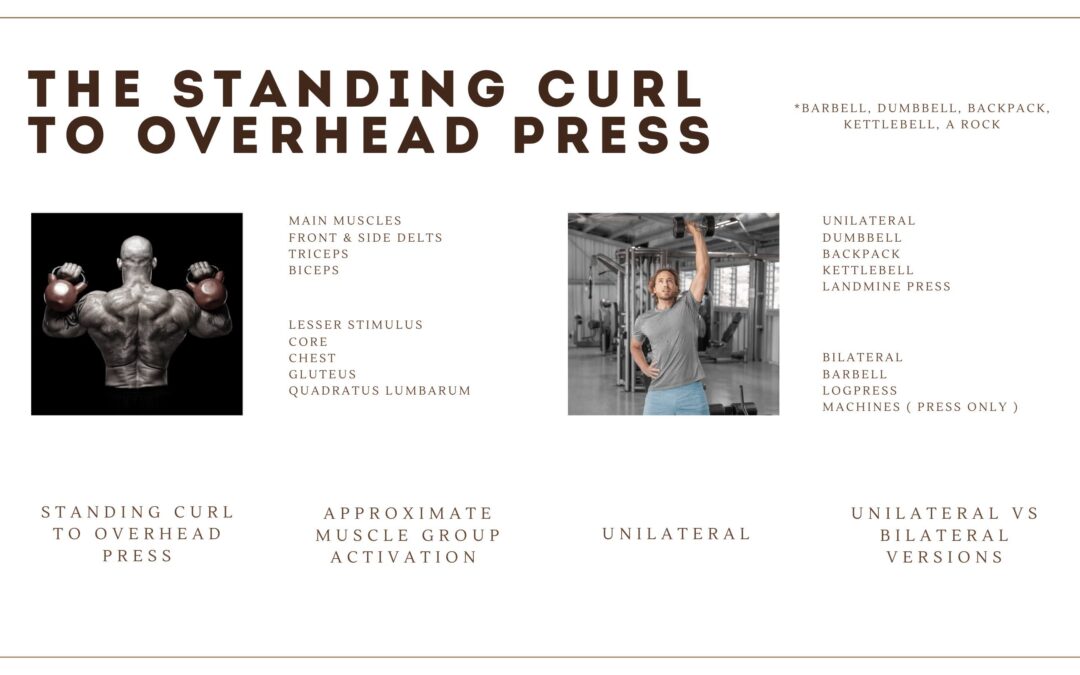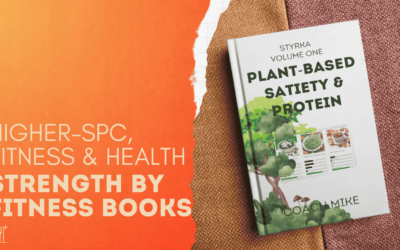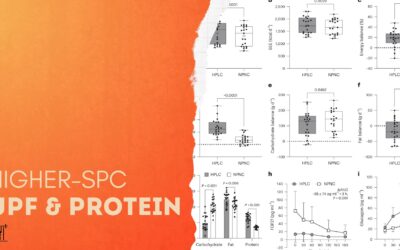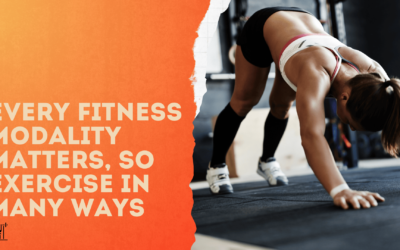Strength By Fitness Exercise Library: Unilateral Standing Curl to Overhead Press. The overhead press is a fabulous exercise, no matter which version you are doing. Machine, dumbbells, barbells, kettlebells, bilateral, unilateral, standing, seated, landmine versions, viking press, logs, rocks, wall press, and flipped V pushups. They are all amazing. But the Unilateral, standing curl to overhead press is my favorite shoulder press variant. Read on to see why Strength By Fitness Coach Mike prefers this amazing version of the shoulder press.
Welcome to Strength By Fitness, fact-based fitness life & coaching.
The Standing Overhead Press: Unilateral Curl to Press variant.
The over head shoulder press can be done in many different ways, you can do it standing, or seated with barbells, dumbbells, or with a shoulder press machine, or smith machine to name a few. Other variants including unilateral landmine shoulder presses, log presses, or my favorite the unilateral curl to shoulder press.
Other Exercise Library articles: Hands Up
Standing Curl to OHP:
Muscle activation
Main muscles
Side & front delts
Triceps
Biceps
Lesser stimulus
Chest
Core
Quadratus lumbarum
Gluteus
Let’s take a look at some coach input for the standing unilateral curl to overhead press.
No matter what type of movement we are considering, the following coaching principle is a major fact-based pillar.
Be intentional & outcome-based with your movement pattern ( exercises ). Understand how you move throughout the entire muscle chain, and the movement pattern. Consider what outcome adaptations, stimulus and performance every movement pattern will lead to with the execution and form that you are using. These outcome considerations do not solely consider strength, athletic performance, power, speed, endurance, and hypertrophy; they also include wear & tear, and acute injury risk.
Coach Mike, Strength By Fitness.
Acknowledge your own pattern, and execution, as well as your clients, and adjust your movement pattern until you get the best possible outcome in performance and adaptations over time, with as little injuries and bad wear and tear as possible.
For obvious reasons no one wants to get injured, its the one sure fire way of drastically destroy your current performance, its not fun at all, its delibitating, and painful. So there´s nothing good at all about injuries. But, injuries and acute pain isnt the only danger to consider.
Unless you are a pro athlete, and paid to ignore what the longterm wear and tear will do to you 10 or 25 years down the line.
Wear and tear should be high on your list of considerations, right up there together with your ongoing adaptations and physical performance, and health.
I am bringing this up, because the world is filled with people who place an excessive and contraproductive value, and focus on hyper isolated movement patterns, with perfect technique and very little athletic effort & physical performance behind those repetitions.
Yes, training like this is super safe, its health and fitness friendly, and it do increase performance too, over time. So, it has many positives, and many reasons to be included part of the year for everyone. But, most people, would benefit greatly from starting to prioritizing their actual athletic capacity across the movement patterns they are training.
Yes, there´s a bigger recovery price to pay from movement pattterns and technicl executions that stimulates and recruit more muscles and motot units. But, there are tremendous benefits in health, fitness, adaptations and performance to gain from training with a higher effort and a bigger stimulus.
Especially so in the gym. But it applies to many sports and many exercise modalities.
In the video below you will see Jeff Nippard take a look at, in his opinion, an ideal regular OHP. And I do find this a pretty good start for most folks out there, as far as the traditional OHP is concerned.
This takes us to the reason why you are doing the exercise you are doing, and how you do it.
So, in the case of the overhead shoulder press, preferring to do it on a machine is perfectly fine. It is a wonderful exercise choice that will build a tremendous amount of strength and muscle mass in the primary muscle chain. That´s your side and front delts, upper chest, and your mighty triceps.
The OHP is a wonderful exercise, no matter the type of OHP you are doing. This is not an either-or exercise decision. We are highlighting nuances and subtle differences here.
As such, it is important to understand that the machine makes it easier. It’s easier to press big; it’s easier to recover from, acute injury risk is lower, the price of recovery is lower, fatigue to stimulus is lower because it’s mostly your primary muscles working.
None of your helpers, the synergists and antagonists, has to engage much because the machine keeps the movement pattern very stable and dialed in, which can be both an advantage and a downside, all depending on what you specifically need from your progression over time.
So the seated OHP machine version has many positive upsides.
I myself love the machine press, be it a dedicated shoulder press machine, or the Smith machine OHP, or why not one of the landmine variations?
But I prefer doing the more athletic, compound versions of most exercises, be it bilateral or unilateral.
Just why is that?
As soon as you are doing a bigger compound lift, you are achieving a bigger total stimulus in your body. There will be more motor units recruited, more muscle fibers from top to toe, and you will train the entirety of the movement pattern across the entire muscle chain in a much bigger way, all of which translates better to any real-life situation.
This differentiating factor once again comes into play if it’s a standing exercise versus a seated one.
It´s not superior, it’s not about that.
Sometimes you really do want to localize your stimulus and adaptations. And sometimes you just don’t have recovery room for yet another brutal, big, compound lift. Other times, you want a finer, more targeted stimulus to avoid overuse fatigue, injury risk, and wear and tear.
Think of long-distance running, and how no one can survive 5 days of big long-distance effort every week, all year round. There´s wear and tear from repetitive high-effort movements, and a price of recovery to pay as well. This is why highly competitive long-distance runners do 1 or 2 harder workouts per week and lots of easy ones.
It is true that lifting weights is different, but there are also a lot of the same considerations. It’s just the ratio that’s a little different.
Muscles, tendons, insertions, and bone mass love being active and being forced to adapt, and resistance training excels at this; higher effort compound exercises even more so.
But there is an upper limit where either global recovery becomes the priority, and or the local price of recovery in one or several muscles, tendons, bones, wear and tear, and stimulus versus our capacity for recovery and the resulting progression rate, this real-life chain of actions and consequences will result in.
However, assuming that this stimulus versus capacity for recovery is not at play, I will choose the standing, unilateral OHP any time over the seated OHP in a machine.
Just as I tend to favor bigger compound exercises for most people, at most times ( but not always for the stated reasons above ).
Below this curl to OHP video ( take note that he is doing it with two arms at the same time, which is perfectly fine, in this article, I am, however, talking about the unilateral version. I will explain why ).
In this video, he is doing both arms at the same time. I would suggest that you do it one side at a time. This allows for a bigger focus, effort & stimulus across the entire muscle chain for this movement pattern.
Plus, dumbbells are already unilateral, in that each side has to work on its own, so why not maximize the advantages of that?
Standing Curl to OHP:
Muscle activation
Main muscles
Side & front delts
Triceps
Biceps
Lesser stimulus
Chest
Core
Quadratus lumbarum
Gluteus
Bigger compound lifts and a bigger movement pattern.
When you are standing up instead of doing your shoulder presses seated right away, your core is doing a lot more work, and this activation extends through your lower body and upper body chain too.
Whatever weight you have to lift, and press above your head also has to be stabilized and held by your core, glutes, your upper and lower back, and other lower body muscles.
This is, of course, why isolation exercises have a slightly better stimulus to fatigue ratio. There are a lot fewer muscles involved. But, as far as you becoming a capable, healthy, fit human being that can excel at every moment throughout those real-life movement patterns under big loads, and physical duress, compound movements with a bigger total load, and bigger total activation per rep, and set rules the day.
The same thing applies, in general, for athletic performance and progression adaptations over time.
I am saying in general, because there is nuance to all this, we are flesh and blood. So you can’t always hammer home a new PB, be it top load for 1 rm, or total workload per set. Our bodies get worked hard, and this is great. But this also means that at regular frequencies, we will have to focus on lifting our performance floor instead of our ceiling.
As such, isolation work has its given place. And it can make up a fair bit of volume. Especially so for higher performance bodies with a ton of big effort and wear and tear, think pro athletes when you read that, but also equally hard training non-competitive people.
Your ongoing foundation really benefits from focusing on performance; however, because health and body composition follow, no matter the approach. Actual real-life physical performance, however, strongly favors bigger and injury-free lifts in the gym.
Complemented with the appropriate lower effort volume to keep you healthy, fit and uninjured across decades of time.
Coaching cues on the Coach Mike, Unilateral Curl to OHP press.
With that lengthy but needed introduction out of the way, let us take a look at my personal favorite OHP press, and the how and why of how I approach exercise, performance, progress, and movement patterns in general, as well as specifically speaking for the curl to OHP.
We are not talking about absolutes here. There´s no truth to the oft-repeated claim “you have to do this exercise like this”. Jeff Nippard is great, but in some of his YouTube videos, he will at times come off as providing a unique way to do a movement pattern in the most optimal way, and there are always, and only, good foundations to build upon. But the most optimal for each and every person will build upon those foundations and introduce individual tweaks.
With that in mind.
Super strict movement, as Jeff and Dr Mike favor, has its benefits. Machines, free weights, isolated reps with as few total numbers of muscles being activated as possible have their uses, and big explosive movement with big loads, and lots of effort have their use cases too.
And it all works.
But if we are talking about useful physical capacity, no matter if that’s for a pro athlete or a non-competitive human being who simply wishes to be as fit, healthy, and physically capable in real life, as they are pain-free, strong, durable, fast, and toned looking. Then its easy to understand, and find the data in studies and real life to prove that movement patterns done on the regular with a bigger effort, and activation across the entire muscle chain will elicit better physical capacity adaptations and progression, while also providing better performance, and equal hypertrophic progress relative to shorter range of motion, as well as stricter, more isolated exercises done with less effort and load.
So, there is nothing wrong with super strict and controlled movements, and there is nothing wrong with going all in on effort, load, and big lifts with a full range of motion.
There is, however, a question of balance between the local price of recovery, versus your global capacity, wear and tear, as well as the need for some periods over the year when we focus on lifting our performance floor instead of the ceiling.
This applies to all sports and fitness modalities. You need the big effort, and you need the lower effort volume, too. Depending on sport modality and desired outcomes, the ratio varies, but everybody needs to train across the entire range of fitness levels and effort.
Cues & structured steps to perfect my Standing, Unilateral curl to OHP.
Bottom.
Stand up, tall and proud.
Weight in one hand.
Shoulder-wide feet ( give or take a few centimeters to what’s the most comfortable and stable foot position for you )
Keep the active arm straight down, fully lengthened, and keep it right next to your body, holding the load in one hand.
Brace your core, and breathe in.
Chest up.
The Curl.
Now, curl the weight up to shoulder height.
Just like any good ol dumbbell biceps curl. There´s no need for an explosive hip hinge or some form of clean and jerk motion.
Rack the weight at that top position by letting your hand and weight sink into your shoulder. Dont replicate the model in the video, really let the hand and weight sink fully into your shoulder and rack that weight properly.
Elbow should be resting tight against the side of your body in this racking position.
Hand and weight should be at the same vertical height as your shoulder.
Do not start pressing with the weight at your face level, start the press with the weight at your shoulder height.
The press.
Breathe in,
Tilt your head and scapula slightly to the opposing side of your pressing arm, if needed, and press the weight straight up.
Think of that pressing motion as a straight line that goes straight through the roof, all the way from your foot, knee, hips, shoulder, elbow & hand.
Control the weight at the top, for a second or two, and lower it with control back down to the shoulder rack.
From there, curl it with control all the way back down to the start.
Between each rep.
Now that was rep 1, breathe in, and recover for as many seconds, as you need, brace your core and do it all again until you reach the desired RIR.
Once done with your first arm, its time to take a few seconds to breathe in and recover, before you do the next arm in the same way.
Depending on how good your health and fitness are, and exactly how hard you pushed yourself there´s going to be a range of rest between arm A and B, and that´s perfectly fine. You do not have to go from your first arm to your second arm in the blink of an eye, but if you can with no performance penalty, go ahead.
Once both arms have been done, rest anywhere from 2 to 7 minutes. Once again, there´s no amount of rest thats wrong.
The more pressed for time you are, the less total sets and rest between sets. Thats just life, and you have to do what you have to do.
Likewise, if hypertrophy is your main obsession, then you can get away with 90 to 120 seconds of rest and do perfectly well.
But, if you are just as much, or more, about strength, and athletic performnce, than resting all the way up to 7 minutes or so, between each set do have measurable benefits.
The Unilateral Curl to OHP press.
When you do the OHP in a seated position, your front and rear delts and triceps will work just as good as doing it standing straight up.
So as far as rear and front delts go, it’s just as good. No big ifs and buts about it. Same thing with the curl aspect of this exercise, you will get the same biceps activation no matter if you are seated or standing.
But, is that really how you lift things above your head in real life, or how you compete in sports? Or lift things with your biceps?
For most people, the reply will be, of course not.
So, why are you training like that? A simple question that also applies to putting hypertrophy above everything else.
It’s ok to do these things. But I prefer it if we create people that are just as fit, strong, capable, and healthy as they look, as opposed to creating people who look the part but lack in all the other metrics relative to what they could have been.
So, the answer, from a fact-based perspective, is this. In real life, most people, most of the time, will first have to curl anything they wish to press above their head.
It’s either given to you or picked up from the ground, a table, a chair, or a shelf.
So, by forcing yourself to do a full range of motion biceps curl at the start of every OHP rep, you have already activated far more muscles, but you are also creating a movement pattern in the exercise that applies to sports and real life. Creating more strength and muscle mass, of course, but also applicable performance across the actual movement pattern we make use of.
Yes, one could argue that you should start every rep on the ground, and hip hinge it up, or snatch it up. And this is perfectly fine too, and depending on sport-specific needs, it’s what might happen.
But as far as exercise goes, unless you need to master those exact sport-specific versions, doing the kettlebell hip hinge version will result in less activation and adaptations, not more, because it’s the hip hinge velocity that drives the weight up, not the strength and performance of your muscle chain.
That very same reality applies to the OLY versions of this movement pattern, too. So, while you can deadlift it off the ground, you will simply deadlift it up to a standing position, curl the weight up to your shoulder shelf, and press it up, unilaterally, one side at a time. And I am not including the deadlift in this curl to OHP press simply because you can never curl or OHP press a load that would provide meaningful stimulus for the deadlift.
As such, doing the deadlift first really only adds fatigue. Its ok to do, but when you wish to challenge yourself in the deadlift, just deadlift.
So the reason for doing the curl to OHP is that we are going to build far better outcomes across the muscle chain that’s involved in the entire movement pattern by doing it this way.
There is one caveat to this.
You will need to be able to properly curl a big enough load to challenge your shoulders in a good enough way with the OHP. Something which not everyone will be able to do. The good news for these people is that you have regular dumbbell presses, machines, smith machine presses, flipped over V presses, wall shoulder presses, and so on, and so forth.
Hope you enjoy thousands of good workouts with this wonderful curl to OHP alternative from Coach Mike, Strength By Fitness.
All exercises in our library are suitable swap in options for our fitness plans.
Take a look at our bodyweight/outdoor gym fitness plan if you are looking for a nice home for my unilateral curl to OHP exercise.
Related content
Outdoor/bodyweight fitness plan
Boxing Foundations. Article 1: Hands Up
recent articles
STYRKA Books, Strength By Fitness Fact-based Book Series.
In STYRKA VOLUME ONE, the first of Strength By Fitness fact-based series of books we are inviting you to a realm of healthy food plans and recipes, fitness facts, health science, sleep, recovery, endurance, strength, habits, and more.
Look forward to a complete approach to plant-based eating with a clear focus on maximizing and improving health, aging, and fitness progression over time. This book is delivered with a complete 7-day food plan and a wide library of swap-in meals so you can create a lifelong food adventure with nothing more than this book as your foundation.
Coach Mike further explains the ins and outs of a nutritionally complete high-protein, higher-SPC food approach, no matter diet tribe preference.,
You will also touch base with our fact-based big pillar coaching ideas across fitness, recovery, health, habits, sleep, and nutrition, and many cited studies to back it all up.
In short, STYRKA Volume One provides you with all the tools you need to create vastly better health and fitness progression, food and lifestyle habits, and the body composition and athletic capacity that you strive to achieve.
Comparing SPC, UPF & Protein Levels, Fact-based Outcomes.
IN THIS ARTICLE, COACH MIKE EXAMINES TWO CONTRASTING HIGH-PROTEIN INTAKE STUDIES, ONE FROM 2005 AND ANOTHER FROM 2025. DEMONSTRATING HOW THEY RELATE TO AND ULTIMATELY VALIDATE YOUR HIGH-PROTEIN, HIGHER-SPC LIFESTYLE.
I’ll begin by introducing SPC (satiety per calorie), a modern food metric, and explain its relevance to a study conducted two decades ago. We will after that delve into the impact of ultra-processed foods (UPF) on overall food consumption and compare outcomes between a high-protein UPF intake and a lower-protein UPF intake under ad libitum feeding conditions. This comparison will illuminate how these findings fit into the broader fact-based SPC food approach.
All Fitness Modalities Matter As They Provide Unique Benefits.
All fitness modalities provide a big overlap of benefits & unique health & fitness outcomes. Training across all modalities makes you fitter & healthier. It will not hold you back.
Coach Mike, Strength By Fitness.
Welcome to another fact-based article from Strength By Fitness. today, we are taking a look at the beneficial outcomes of strength training together with aerobic exercise relative to doing just one of them.
Members & Clients Recipe: Plant-based Protein & Fiber Balls. Health & Fitness Friendly High-protein, SPC snack.
Plant-based Protein & fiber Balls. Rich in nutrition, high in protein, and SPC. Yet indulgent & tasty. Another Strength By Fitness winner that's exclusive for our paid members & Clients. Sign up today to enjoy our exclusive fact-based articles and recipes.
SPC 66 to 80. Protein 65, healthy fats, carbs & fibers, prep, cook, and store in the freezer.
Members & Clients Recipe: BBQ Seitan Salad, Served With Lemons. High SPC & Protein.
Our BBQ Seitan, salad served with lemons, provides 114g of Protein, 23g of fiber, and a very high SPC between 80 to 100. That makes this Strength By Fitness highest-ranked plant-based SPC meal. Paid Reader & Client Exclusive Recipe.
Outside of all that protein, and that wickedly high Satiety range, our BBQ Seitan Salad with lemons provides plenty of micronutrients, and a delicious taste sensation, that´s ready to make your senses tingle, and keep you full for hours while boosting your health, fitness, and a waist-friendly body composition.
Top Ranked Plant-Based SPC Meals From Strength By Fitness.
On this page, you can browse a curated list of Strength By Fitness highest plant-based satiety range recipes. A high SPC score guarantees you a meal that is nutritionally very rich, with a health and fitness-friendly high-protein profile, plenty of fiber, and micronutrients per unit of energy ( calories ).
In other words, these meals are pretty much as good as it gets when it comes down to creating a healthy food life that will correlate with better food habits, health, and fitness outcomes over time.
Enjoy
Coach Mike & Mida
We appreciate you
so stay healthy & never stop training
Contact
Private In-App Messaging is Available For All App + Coaching Clients
Adress
Coaching Is Available Online Via App on IOS & Google Play, and In-person, On-location.






